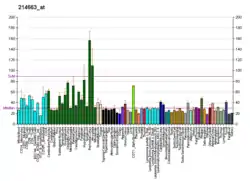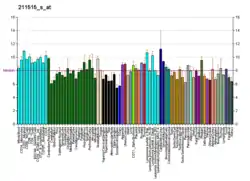RIPK5
Dual serine/threonine and tyrosine protein kinase is an enzyme that in humans is encoded by the DSTYK gene.[5][6]
| DSTYK | |||||||||||||||||||||||||||||||||||||||||||||||||||
|---|---|---|---|---|---|---|---|---|---|---|---|---|---|---|---|---|---|---|---|---|---|---|---|---|---|---|---|---|---|---|---|---|---|---|---|---|---|---|---|---|---|---|---|---|---|---|---|---|---|---|---|
| Identifiers | |||||||||||||||||||||||||||||||||||||||||||||||||||
| Aliases | DSTYK, CAKUT1, DustyPK, RIP5, RIPK5, HDCMD38P, dual serine/threonine and tyrosine protein kinase, SPG23 | ||||||||||||||||||||||||||||||||||||||||||||||||||
| External IDs | OMIM: 612666 MGI: 1925064 HomoloGene: 19711 GeneCards: DSTYK | ||||||||||||||||||||||||||||||||||||||||||||||||||
| |||||||||||||||||||||||||||||||||||||||||||||||||||
| |||||||||||||||||||||||||||||||||||||||||||||||||||
| |||||||||||||||||||||||||||||||||||||||||||||||||||
| |||||||||||||||||||||||||||||||||||||||||||||||||||
| Wikidata | |||||||||||||||||||||||||||||||||||||||||||||||||||
| |||||||||||||||||||||||||||||||||||||||||||||||||||
This protein is also known as the Dusty protein kinase and the Receptor interacting protein 5 (RIP5).
This gene encodes a dual serine/threonine and tyrosine protein kinase which is expressed in multiple tissues. Multiple alternatively spliced transcript variants have been found, but the biological validity of some variants has not been determined.[6]
In melanocytic cells RIPK5 gene expression may be regulated by MITF.[7]
Mutations in this gene have been associated with hereditary spastic paraplegia type 23.[8]

It has also seen that DSTYK deletion causes pigmentation problems and high cell death after ultraviolet irradiation. In a study conducted by Giner-Delgado, Carla, et al.[10] it has been observed that the inversion of the first intron has been associated with changes in expression in the proximal genes and with an increase in the expression of DSTKY itself. Due to the deleterious effect caused by the absence of expression, the positive selection of this investment could explain its increase in the African population. They also noted that the investment has been linked to an increased risk of glaucoma in Europeans (which again shows the possible positive selection, since glaucoma is more common and severe in individuals of African descent.
References
- GRCh38: Ensembl release 89: ENSG00000133059 - Ensembl, May 2017
- GRCm38: Ensembl release 89: ENSMUSG00000042046 - Ensembl, May 2017
- "Human PubMed Reference:". National Center for Biotechnology Information, U.S. National Library of Medicine.
- "Mouse PubMed Reference:". National Center for Biotechnology Information, U.S. National Library of Medicine.
- Zha J, Zhou Q, Xu LG, Chen D, Li L, Zhai Z, Shu HB (Jun 2004). "RIP5 is a RIP-homologous inducer of cell death". Biochem Biophys Res Commun. 319 (2): 298–303. doi:10.1016/j.bbrc.2004.04.194. PMID 15178406.
- "Entrez Gene: RIPK5 receptor interacting protein kinase 5".
- Hoek KS, Schlegel NC, Eichhoff OM, et al. (2008). "Novel MITF targets identified using a two-step DNA microarray strategy". Pigment Cell Melanoma Res. 21 (6): 665–76. doi:10.1111/j.1755-148X.2008.00505.x. PMID 19067971.
- Lee JYW, Hsu CK, Michael M, Nanda A, Liu L, McMillan JR, Pourreyron C, Takeichi T, Tolar J, Reid E, Hayday T, Blumen SC, Abu-Mouch S, Straussberg R, Basel-Vanagaite L, Barhum Y, Zouabi Y, Al-Ajmi H, Huang HY, Lin TC, Akiyama M, Lee JYY, McLean WHI, Simpson MA, Parsons M, McGrath JA (2017) Large intragenic deletion in DSTYK underlies autosomal-recessive complicated spastic paraparesis, SPG23. Am J Hum Genet 100(2):364-370
- Giner-Delgado, Carla, et al. "Evolutionary and functional impact of common polymorphic inversions in the human genome." Nature communications 10.1 (2019): 1-14.
- Giner-Delgado, C., Villatoro, S., Lerga-Jaso, J., Gayà-Vidal, M., Oliva, M., Castellano, D., ... & Olalde, I. (2019). Evolutionary and functional impact of common polymorphic inversions in the human genome. Nature communications, 10(1), 1-14.
Further reading
- Robertson NG, Khetarpal U, Gutiérrez-Espeleta GA, et al. (1995). "Isolation of novel and known genes from a human fetal cochlear cDNA library using subtractive hybridization and differential screening". Genomics. 23 (1): 42–50. doi:10.1006/geno.1994.1457. PMID 7829101.
- Bonaldo MF, Lennon G, Soares MB (1997). "Normalization and subtraction: two approaches to facilitate gene discovery". Genome Res. 6 (9): 791–806. doi:10.1101/gr.6.9.791. PMID 8889548.
- Seki N, Ohira M, Nagase T, et al. (1998). "Characterization of cDNA clones in size-fractionated cDNA libraries from human brain". DNA Res. 4 (5): 345–9. doi:10.1093/dnares/4.5.345. PMID 9455484.
- Dias Neto E, Correa RG, Verjovski-Almeida S, et al. (2000). "Shotgun sequencing of the human transcriptome with ORF expressed sequence tags". Proc. Natl. Acad. Sci. U.S.A. 97 (7): 3491–6. Bibcode:2000PNAS...97.3491D. doi:10.1073/pnas.97.7.3491. PMC 16267. PMID 10737800.
- Strausberg RL, Feingold EA, Grouse LH, et al. (2003). "Generation and initial analysis of more than 15,000 full-length human and mouse cDNA sequences". Proc. Natl. Acad. Sci. U.S.A. 99 (26): 16899–903. Bibcode:2002PNAS...9916899M. doi:10.1073/pnas.242603899. PMC 139241. PMID 12477932.
- Gerhard DS, Wagner L, Feingold EA, et al. (2004). "The status, quality, and expansion of the NIH full-length cDNA project: the Mammalian Gene Collection (MGC)". Genome Res. 14 (10B): 2121–7. doi:10.1101/gr.2596504. PMC 528928. PMID 15489334.
- Peng J, Dong W, Chen Y, et al. (2007). "Dusty protein kinases: primary structure, gene evolution, tissue specific expression and unique features of the catalytic domain". Biochim. Biophys. Acta. 1759 (11–12): 562–72. doi:10.1016/j.bbaexp.2006.10.004. PMC 4277547. PMID 17123648.
- Ewing RM, Chu P, Elisma F, et al. (2007). "Large-scale mapping of human protein-protein interactions by mass spectrometry". Mol. Syst. Biol. 3 (1): 89. doi:10.1038/msb4100134. PMC 1847948. PMID 17353931.





